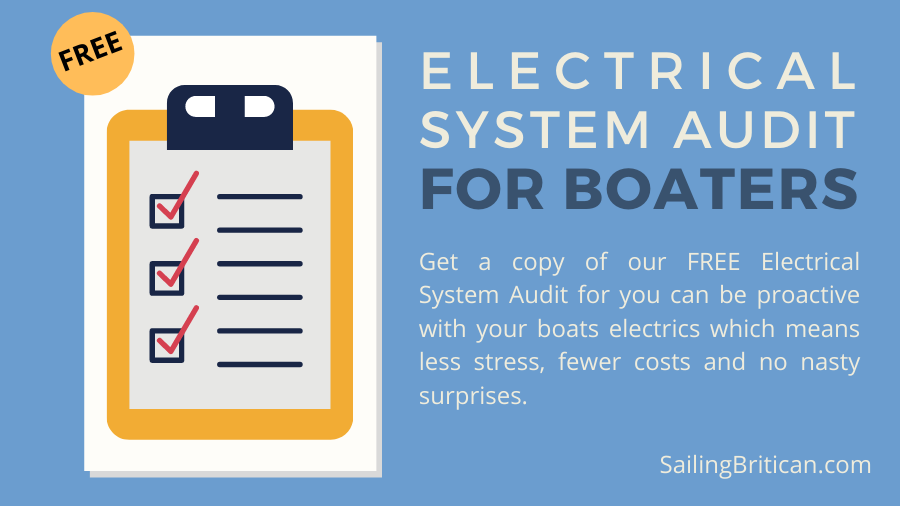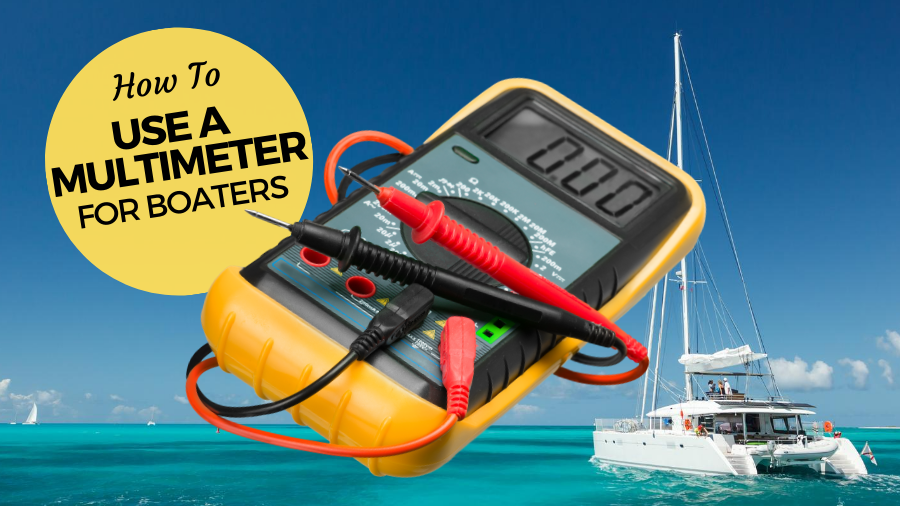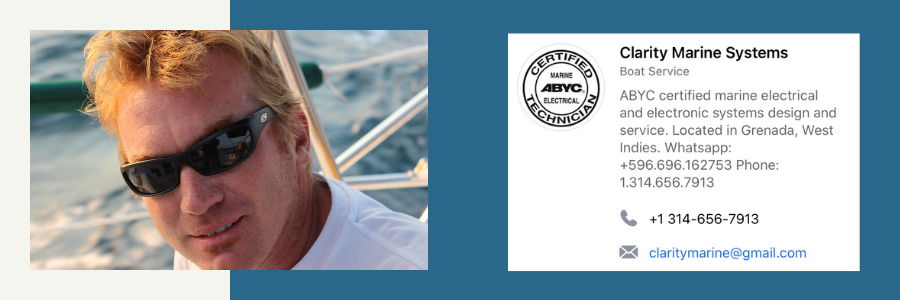In this article and video, we cover multimeter basics for boaters. A multimeter is the most important tool to have on board when it comes to your electrical systems.
Used to check voltage, a multimeter performs resistance and continuity tests, and troubleshoot basic electrical issues, just to name a few applications. The tool can seem daunting at first, but once you learn the basics, a multimeter is very straightforward.
A range of models are available at differing price points – some for as little as $20. At least a few varieties should be available at your local hardware store or marine chandlery. And of course, you can find a wide selection on Amazon (see links below).
The multimeter basics for boaters video includes an overview of multimeter settings, alternating current (AC), direct current (DC), and how to measure voltage. We also cover current, or amp, measurement, and impedance, or continuity, measurement. We show practical examples of testing a boat electrical outlet, demonstrating continuity on a wire, and measuring the voltage of a refrigeration compressor.
The video also covers different kinds of multimeters and clamp meters in addition to offering some tips on what to do to ensure you get an accurate reading. We also explain why you need to measure various systems and what to do if something isn’t working. (Video at the bottom of the article)
Don’t put your head in the sand about electricity on a boat!
It’s not a dark art. It’s actually not very complicated at all but you do have to invest some time to learn how it works, how to troubleshoot, and ultimately how to fix electrical issues. You don’t have to really understand volts, amps, or impedance – you just need to understand what you’re measuring, whether the measurement demonstrates an issue or not, and what you need to do if there is a problem.
Previous to getting aboard Britican we took a week-long course on boat systems. Our teacher explained that one of the most important items to have on a boat is a multimeter. During the course get got an overview of what each setting measured, how to ensure a clean reading, and how to get a reading. Learning in a course setting is one thing.
Being stranded on a boat in a bay with a failed electrical system without the support of a teacher is different.
At first, we found it difficult sticking two metal objects in a socket or on live wires but out of necessity we had to get comfortable with our multimeter. If you already have your boat but haven’t taken the leap into playing with electricity, I urge you to watch the video and then have a play with your multimeter.
Get used to using it. Measure the volts of various systems, check out how many amps your major systems are drawing and have a go at testing the continuity of a wire.
Over the past seven years, our biggest issue with electricity has been corrosion. Either the terminations of wires have turned brown-black and lost their capacity to work or somewhere along a wire it was nicked and eventually turned green and failed. Corrosion on a boat happens all the time.
It’s important to understand the basic electrical troubleshooting process.
When something doesn’t work – perhaps a light doesn’t turn on, or a pump fails or you can’t get your shore power to work it’s time to grab the multimeter. Within a few short minutes, it’s relatively easy to narrow down what part of the system isn’t performing. And once you do that, it’s a matter of taking off the fitting and investigating. More times than not it’s just corrosion that needs to be cleaned. You simply have to cut the wires back (once the electricity is turned off) to remove the corrosion and then reattach the fitting. Sometimes you just need a new fitting.
Additionally, it’s imperative to know what your systems draw.
It took years for us to truly understand all the systems we have on our boat. And there’s still quite a bit we don’t know. At first, we had no idea how many amps each pump, light, fixture, appliance took. All we knew is that we had to use our generator to cook (we have an electric oven) and every day for about one to two hours we needed to run the genset to charge our batteries.
Over time, and talking to other boaters, we discovered the benefits of solar power. We started to question whether solar could benefit us. Our ideal situation was to be able to run the genset every few days rather than every day. We also wanted to be able to run our washing machine, water maker, and perhaps one of our air-conditioning units from our inverter rather than turning on the generator.
It took us several years to come up with the right solution.
It also helped that over time the cost of technology reduced in price. We measured the amps on all our systems to determine how much solar we needed and what kind of battery system/inverter combination would support the loads we wanted to use.
I suppose you need to live on the boat for a while to figure out what you use and how you use it. After five years of full-time cruising, we upgraded to a lithium-ion battery bank in addition to installing three huge solar panels on a frame at the back of our boat.
Boaters often say that Lithium and Solar are a gamechanger and I have to agree. We still look at the level of our batteries but it’s only to confirm how much electricity we have stored. Gone are the days where we had to run the generator to top up the battery bank. When we do laundry during a sunny day we’re overjoyed to see that we’re in positive amps even with all our domestic systems running and washing the clothes.
Aside from understanding the draw of various systems to manage your power, it’s also important so that you know when something is wrong.
If a system is drawing 15 amps when it should only be at 7 amps there is a problem. If you should be getting 30 amps from your solar but you’re only getting 18 there is an issue. Knowing just the multimeter basics for boaters you can easily use a clamp meter to get this information.
As a liveaboard sailing cruiser, you have to realize that you are in charge of the power plant. It’s not like a house where electricity just comes in. You’re the one who’s managing how much electricity you get, how you get it, and how you use it. Furthermore, you’re often the one that has to figure out what’s going wrong when systems fail.
Knowing multimeter basics for boaters will drastically increase your confidence when it comes to boating electrical systems. Make this a priority to understand and test out what you learn.
Multimeter Basics For Boaters Video
Here’s a tool for understanding your boat’s electrical systems!
For a limited time, we’re offering a checklist to help you know what you need to know about your boat’s electrical systems, the basics of troubleshooting, and how to determine when it’s time to call in an expert. Get the Electrical System Audit here.
Are you in or going to Grenada?
Make sure to contact Aaron if you’re in Grenada.
Owner Aaron Downey grew up powerboating and began racing sailboats in the U.S. in 2000. He and his wife purchased their first cruising sailboat in 2012. After completing his USCG Master’s license in 2012 and ABYC exams in 2013, Aaron founded CMS as a side business at the repeated requests of fellow boat owners and yacht yards.
His many years designing large, complex land-based technology and electrical systems paired nicely with his experience on the water, creating a unique and robust skillset.
Since then, CMS has seen a long list of happy boat owners in its wake, throughout the U.S. and Caribbean. Let us assist you with your system design or problem-solving – no matter how big or small, simple or complex. From small sailboats to superyachts, simple circuits to large yacht refits, CMS has been there. Click the image below for more information on Aaron from Clarity Marine Systems.
Any questions or comments on Multimeter Basics For Boaters?
Please leave them below.
Other articles of interest
- Understanding Your Boats Electrical Systems
- The Beginners Guide To Marine Boat Batteries (Part 1 of 3)
- How To Manage Your Boat Battery Bank (Part 2 of 3)
- How to Increase the Lifespan of Your Batteries (Part 3 of 3)
- Our Solar Power Installation
- Lithium Battery Upgrade
- How To Prevent Boat Fails


Plugged boat into 110V outlet in dry dock. Power was on. Plugged a heater in and the ground fault on the pole kicked out. Reset pole Ground fault and have power again, at least for night lights. Do not have a way to reset main pole breaker so I do not want to cause the beaker to trip. How can I check what may be tripping the ground fault on the pole?